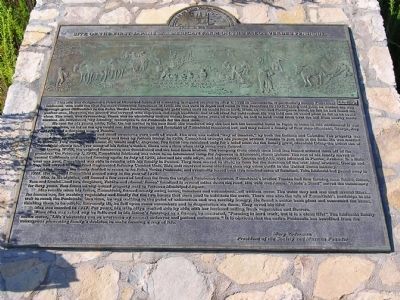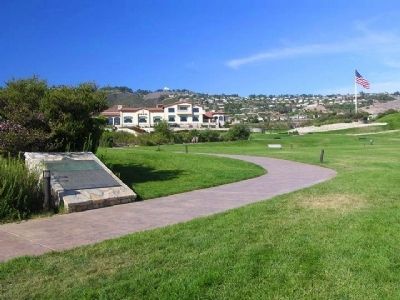Rancho Palos Verdes in Los Angeles County, California — The American West (Pacific Coastal)
Site of the First Japanese American Farm on the Palos Verdes Peninsula
This site was designated a Point of Historical Interest at a meeting in regular session on May 1, 1992 in Sacramento. It particularly honors Kumekichi Ishibashi, who built the first Japanese-American farmhouse in 1906. He was born in Japan and came to San Francisco in 1905. Taking odd jobs, he worked his way through great difficulties to the Palos Verdes Peninsula, saving gold coins until he could lease land. When he reached Portuguese Bend, he felt that he found the perfect area. However, the ground was covered with sagebrush and huge boulders…not at all ideal for cultivation. He was told that he could plant as far as he could clear. The work was devastating. There was no electricity and no water during three years of drought. He had to haul water from over the hill from nearby cattle ranches. He introduced "dry farming" techniques to the Peninsula for the first time.
He sent for his young bride, Take. On her first arrival to the new land she wondered why she left her beautiful home in Japan to come to this wilderness. It was a barren place as far as the eye could see. But the courage and foresight of Kumekichi reassured her, and they raised a family of four sons: Masaichi, George, Kay and Aki and a daughter named Yasuko.
The original farm house and small structures were built of wood. The area was called "Bay of Smokes" by both the Indians and the Cabrillo. The property was owned first by the Sepulveda Family and later by Jotham Bixby. In 1910, Kumekichi brought his younger brother, Tomizo, to join him at the farm. He was married to Umeno. Two workers also came, K. Ozaki and C. Hayashi. The latter two only remained a brief period of time. As the family grew, Masaichi (Mas) - the oldest son of Kumekichi - took over many of his father's duties. There was a time when sixty acres were farmed.
During WWII, the original farmhouse was demolished and land lease broken. The company from which their land was leased ordered them off the premises. On February 1, 1942, Kumekuchi Ishibashi was taken to an internment camp for Japanese in Bismarck, North Dakota. The rest of his family moved to central California to start farming again. In July, 1942, Mas, his wife, Miye, and his brothers, George and Aki were interned at Poston, Arizona. In a little over one year, Kumekichi was able to reunite with his family in Poston. They then moved to Utah to farm for the duration of the war. Mas' brothers, George and Kay, served in the 442nd Regimental Infantry Combat Unit. This unit received more citations than any other outfit of the United States military.
After the war, the family decided to return to Palos Verdes Peninsula and eventually leased over 500 acres of farmland. Take Ishibashi
had passed away in 1928. Her husband Kumekichi passed away in the year of 1954.
Mas, in his eighties, still farmed a few acres of land not far from the original farmhouse location. Kumekichi's brother Tomizo had four farming sons, Ichiro, James, Tom and Daniel... and two daughters, Yukiko and Naomi. James' farmland is several miles down the road. His wife was Annie. "Annie's Stand" served the community for forty years. Tom farms on city-owned property next to Torrance Municipal Airport.
Mas recalls his father Kumekichi farmed mostly string beans, tomatoes and cucumbers—all without water. The water they had was used several times---for human use, washing vegetables and finally for the two horses that were used to cultivate the earth. There was also the tale of hardship in his trek to reach the Peninsula. One time Kumekichi was walking to the point of exhaustion and was terribly hungry. He found a castor bean and consumed the beans, thinking them to be edible. Extremely ill, he fell upon some cucumbers and in desperation ate them. They saved his life.
Mas was married in 1937. For years, his wife, Miye, worked side by side with her husband, selling fresh vegetables and flowers.
When Mas was asked why he followed in his father's footsteps as a farmer, he answered, "Farming is hard work, but it is a clean life." The Ishibashi family motto states: "Life's obstacles can be overcome by earnest endeavor and patient endurance." It is obvious that the entire Peninsula has benefited from this courageous pioneering family's decision to make farming a way of life.
Mary Roderman, President of the Society and Museum founder
Erected 2005 by Rancho de los Palos Verdes Historical Society.
Topics. This historical marker is listed in these topic lists: Agriculture • Asian Americans. A significant historical month for this entry is February 1923.
Location. 33° 43.707′ N, 118° 21.044′ W. Marker is in Rancho Palos Verdes, California, in Los Angeles County. Marker can be reached from Trump National Drive, ¼ mile south of Palos Verdes Drive. Located at Trump National Golf Club, on a paved path between the clubhouse and the ocean cliffs. This trail and certain others are open to the public, and a public parking lot is marked nearby. Touch for map. Marker is at or near this postal address: 1 Trump National Dr, Rancho Palos Verdes CA 90275, United States of America. Touch for directions.
Other nearby markers. At least 8 other markers are within 2 miles of this marker, measured as the crow flies. Portuguese Bend Whaling Station (approx. half a mile away); Villa Francesca (approx. 1.3 miles away); Harden Gatehouse (approx. 1.6 miles away); Santa Catalina Island (approx. 1.9 miles away); Portuguese Bend (approx. 1.9 miles away); Palos Verdes Peninsula Habitat (approx. 2 miles away); Royal Palms County Beach (approx. 2 miles away); White Point Nike Missile Site (approx. 2 miles away). Touch for a list and map of all markers in Rancho Palos Verdes.
Also see . . . Contributor's Blog Posts about this Location. Additional photographs of the site (Submitted on September 21, 2009, by Linda Walcroft of Woodstock, Virginia.)
Additional keywords. Japanese Americans
Credits. This page was last revised on September 13, 2023. It was originally submitted on September 20, 2009, by Linda Walcroft of Woodstock, Virginia. This page has been viewed 3,309 times since then and 130 times this year. Last updated on May 28, 2010, by Linda Walcroft of Woodstock, Virginia. Photos: 1, 2. submitted on September 20, 2009, by Linda Walcroft of Woodstock, Virginia. • Syd Whittle was the editor who published this page.

